 The Book of Ceremonial Magic – Arthur Edward Waite
The Book of Ceremonial Magic – Arthur Edward Waite
Bell – 1969 (First published in 1898 as The Book of Black Magic and Pacts)
Imagine, if you will, a man who takes it upon himself to read a bunch of cooky books on black magic and then proceeds to write about how utterly silly they are and how stupid the people who believe in them must be… Sounds like a real cool guy, right? I’m referring, of course, to Mr. Arthur Edward Waite. Waite, famous for creating the Rider-Waite Tarot deck, is the author of this rather interesting book on grimoires, spirits, ceremonial magic and infernal necromancy.
Waite’s writing style can be painfully long-winded and academic, and nowhere is this as apparent as the headache-inducing introduction to this work. I don’t have a fucking clue what it’s about, and I would recommend that you skip it. Aleister Crowley, who is going to pop up a few times in this post, had a personal dislike for Waite and modeled Arthwait, one of the characters in Moonchild, on him. In chapter 12 of that novel, Crowley says; “Arthwait was naturally slow of thought and speech; it took him some time to warm up to real eloquence; and then he became so long-winded, and lost himself so completely in his words and phrases, that he would speak for many hours without conveying a single idea of any kind to his hearers, or even having one to convey.” Keep in mind too that Crowley himself was pretty bad for talking absolute shite.
Some of the minor illustrations within.
That being said, if you manage to slog through the intro, there’s lots of juicy stuff in here. The first half of the book gives the backstories to the most infamous grimoires. Waite breaks them down into three categories: books of transcendental magic – the least bad kind of magic, composite rituals – slightly sketchy magic, and black magic rituals – the purely diabolical. He goes into a satisfying amount of detail on the supposed origins of each text while also supplying his own opinions about their likely dates and places of origin.
The second part of Waite’s book, the Complete Grimoire, is basically all the good bits of the different texts that are discussed in the first half. It lists all the necessary precautions and steps you’ll need to take if you plan on summoning a demon to do your bidding.
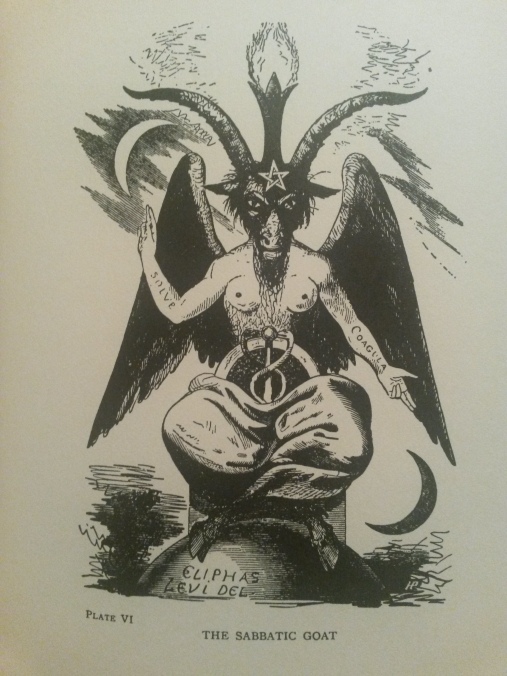 Is this image over used? Waite and I agree that it’s not.
Is this image over used? Waite and I agree that it’s not.
Waite’s overall stance is that Black Magic is really dumb and that these books are all forgeries for idiots. You’d wonder why he bothered writing a book about something that he had such disdain for. (If you’re a long term reader of my blog, you’ll remember that I said almost the exact same thing about his translation of Eliphas Levi’s book, Transcendental Magic.) He seems to have enjoyed making fun of gobshite occultists. Good lad, Waite.
I simultaneously read this along with some of the grimoires that it’s about, and hence the second half seemed quite repetitive to me. The scope of this book is broad enough that it could serve as an introduction to the topic, but the writing is probably a bit too dense for casual readers. You can always check it out online to see if it’s what you want before buying a copy. Personally, I really enjoyed reading it.
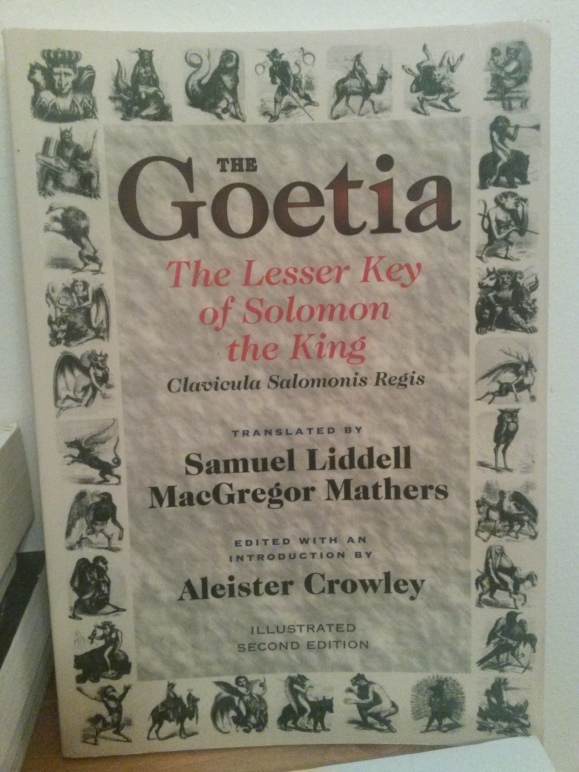 The Goetia – Translated by Samuel Liddell Macgregor Mathers, edited by Aleister Crowley, and supposedly written by King Solomon.
The Goetia – Translated by Samuel Liddell Macgregor Mathers, edited by Aleister Crowley, and supposedly written by King Solomon.
Weiser – 1995
This edition was first published in 1904.
Original edition of the Lemegeton compiled mid 17th century.
Text purports to be from 10th century BC.
The Key of Solomon, perhaps the most famous grimoire, is supposedly a set of magic spells left by King Solomon. The Lesser Key of Solomon, or the Lemegeton, is its dirty sequel. (Although sequel might not be the correct word here. It’s more like when a band releases a collection of crap songs and covers that weren’t good enough to make it onto their last album; the Lemegeton is the Reload of Solomonic grimoires.) The Goetia is the first of four (or five, depending on who you ask) sections of the Lesser Key. It was translated by Samuel Liddell MacGregor Matthews, head of the Golden Dawn, and published by his protégé, Aleister Crowley, although by the time this was published, Mathers and Crowley were no longer friends. It has the usual crap about drawing fancy triangles on the floor and all of that nonsense, but most interestingly, it contains the names and details of 72 demons (most of which come from Weyer’s Pseudomonarchia Daemonum). This edition also includes several of Louis Le Breton’s drawings that originally appeared in the second edition of Collin De Plancy’s Dictionnaire Infernal.
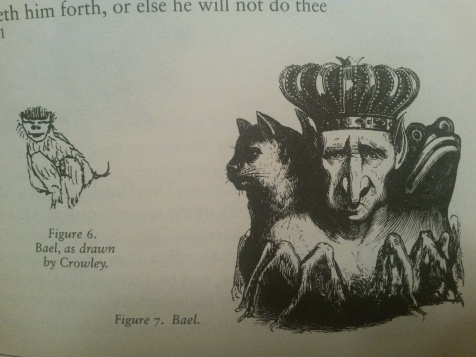 One of Louis Le Breton’s drawings of a demon, accompanied by Crowley’s version.
One of Louis Le Breton’s drawings of a demon, accompanied by Crowley’s version.
This is mildly entertaining to flick through, but the most interesting parts are included in Waite’s book. If you have Waite’s book, this book will only be interesting if you’re a big Crowley fan. The physical book is quite nice, as Weiser editions usually are, and it contains some introductory essays by and about Mr. Crowley. In my opinion, the best parts of this text are the pictures that Crowley drew of the demons:
Notice any patterns?
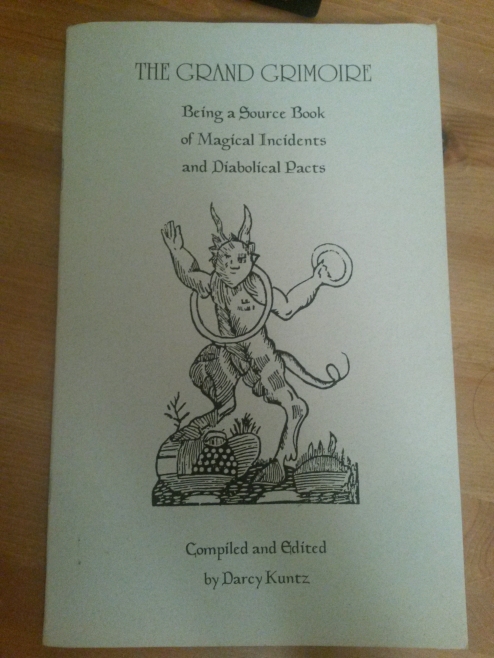
The Grand Grimoire: Being a Sourcebook of Magical Incidents and Diabolical Pacts
Compiled by Darcy Kuntz
Supposedly written by Antonio Venitiana del Rabina and King Solomon.
Holmes Publishing – 2008
Source material exists from 1521, 1522, and 1421.
Text purports to be from 10th century BC.
Now, this is it; the boldest and most infamous of all grimoires. Like the Goetia, the Grand Grimoire has its roots in Solomonic ceremonial magic. The first half gives instructions on how to summon Lucifuge Rofocale, Satan’s right-hand man, and the second half is about how to summon other demons.
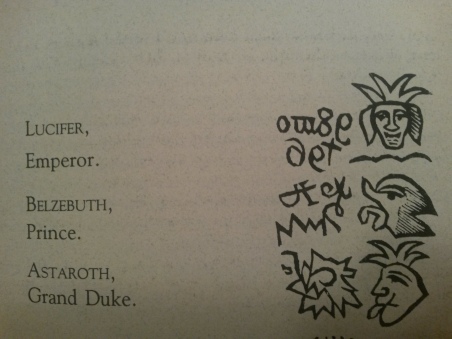 Lucifer and his entourage don’t really come across as super scary in this one.
Lucifer and his entourage don’t really come across as super scary in this one.
I bought this book a long time ago, but the first few times I picked it up to read through it, I became confused by the introduction. The title of the edition I bought is “The Grand Grimoire. Being a Source Book of Magical Incidents and Diabolical Pacts“. There’s no blurb on the back, and there is very little information about this edition online. All of these factors led me to think that it might actually be a book about the book that I wanted to read. I sent a message to Darcy Kuntz, the editor, on Goodreads, but he never responded to me. However, after looking through it and doing a bit of research, I have figured out that this is a version of the Grand Grimoire and not just a book about that text.
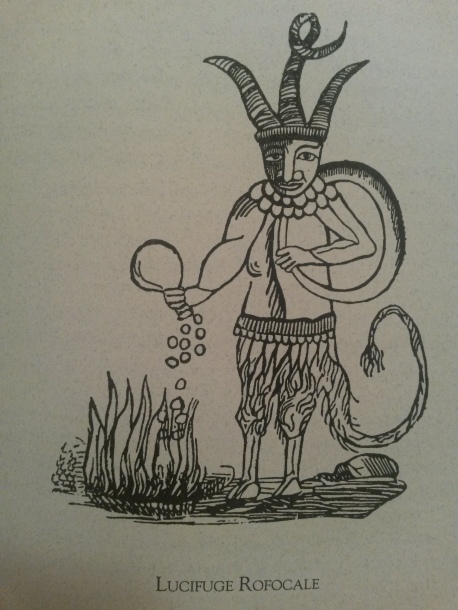
The bulk of this edition is a word for word transcription of the edition of the Grand Grimoire that our friend, A.E. Waite, published in the June 15, 1895 edition of his magazine, the Unknown World. (How fucking awesome is it that those scans are online?!? The Grand Grimoire starts on the 35th page of the pdf.) Kuntz’s book also includes some passages taken from Waite’s Book of Ceremonial Magic. The confusing introduction of this edition of the Grand Grimoire is a mash-up of the introduction in Waite’s magazine and some other sources. Entire phrases are lifted from the entry on the Grand Grimoire in Lewis Spence’s Encylopedia of Occultism, to which no references are given. Tut-tut, Mr Kuntz. Your name says it all! Plagiarism aside, I just wish the introduction had been a little clearer about how the book had been compiled. Then again, maybe the organisation was deliberately awkward to give off a more genuine grimoire experience. Summoning Belzebuth just wouldn’t be the same if the instructions you were following were organized in a coherent order!
There are other parts in Latin or Italian that Kuntz claims were taken from a source titled “Le Grand Grimoire“, but he doesn’t elaborate on what this source was or how it differs from Waite’s translation. I have found a pdf of a more complete translation than Waite’s. This version includes an English translation of the Sanctum Regnum section, although the Citatio Praedictorum Spiritum section remains in Latin in both the pdf and Kuntz’s edition. The pdf version also includes a third section which is made up of other “magic secrets”, including the method of raising the dead that Eliphas Levi alluded to in the chapter on Necromancy in his Rituals of Transcendental Magic. (LET THE DEAD RISE FROM THEIR TOMBS!) What’s interesting about the inclusion of this ritual is the fact that Waite actually claims that Levi made it up. In chapter IX of the Complete Grimoire, he claims that this ritual “must be given on the authority of Lévi; for no available editions of the work which is in question, nor yet of the Red Dragon, nor indeed any ritual of my acquaintance, contains it. There is reasonable probability that he invented it to make out his case at the moment.” I know that the pdf version is definitely worded differently to Kuntz’s version, so either it is a different translation or it was based on another manuscript of the grimoire. If it was based on another text, maybe that text is the one that Levi had read. Then again, maybe somebody read Levi and decided to add his bit onto the end because they thought it was cool; I certainly did. This is the problem with pdf versions; you don’t really know how genuine they are. (It’s bit sad when you contemplate that you’ve spent hours of your life researching the authenticity of an online edition of a translation of a forgery.)
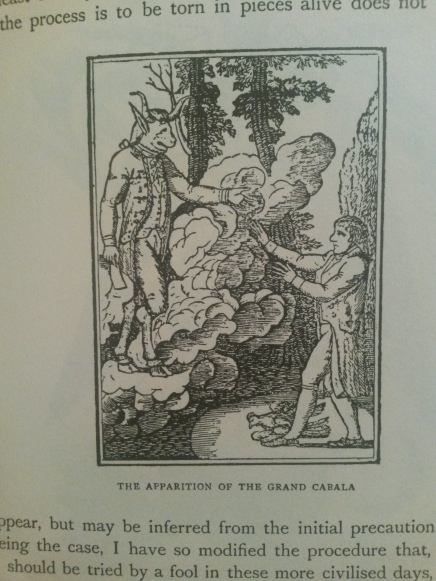
This is the lad who shows up if you perform the ritual of the Black Hen correctly.
Other things to note regarding the compilation of the pdf version:
One of the spells, “The Secret of the Black Hen”, was mentioned in Waite’s book, wherein he suggests that it was a late addition to the Red Dragon (another name for the Grand Grimoire). The pdf also includes several spells from the Grimorium Verum, including instructions on “HOW TO CAUSE THE APPEARANCE OF THREE LADIES OR THREE GENTLEMEN IN ONE’S ROOM AFTER SUPPER”. There’s also another short section on commonly held superstitions that ends with the statement, “I have related these beliefs to amuse our readers but not to obligate the readers to believe all of them because they are mostly nonsense”. This pdf edition seems to be a compilation of different bits and pieces from a variety of grimoires and books about grimoires. It’s still pretty cool though; some of the spells at the end are grizzlier (and often far sillier/funnier) than the first two parts of the “authentic” text.
If you know anything about the compilation of the different versions of the Grand Grimoire, please leave a comment below or email me.
* * * *
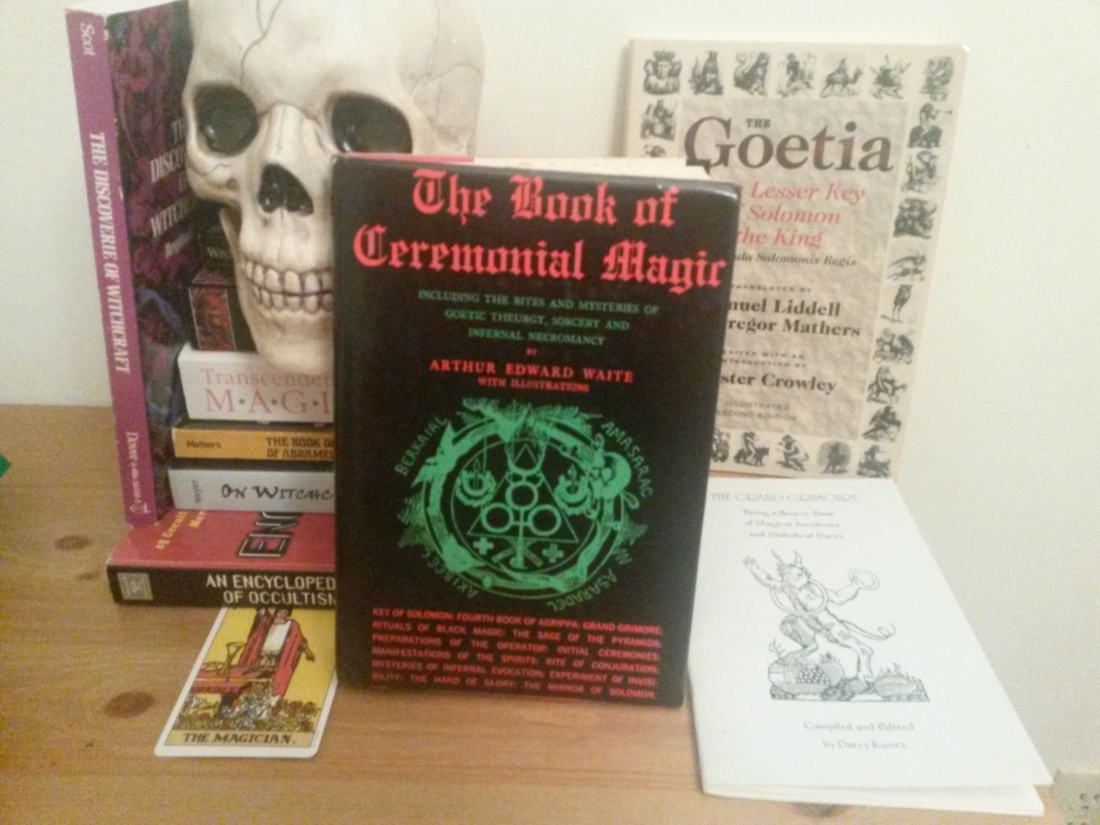
I have other grimoires in my collection, both books and pdfs, and I’ll doubtlessly get around to them at some stage. I suppose I’ve talked more about the actual books and what they’re composed of than the efficacy of what’s actually written within. It’s hard to imagine somebody reading through these texts and trying to carry out the rituals, but I’m sure that attempts have been made. I think that the tasks described in these books, although ludicrously tedious and difficult, are less likely to prevent somebody from attempting the rituals than is the fundamental problem of Black Ceremonial Magic addressed by Waite: these rituals require the sorcerer to supplicate God to give them control over evil demons in order that they may perform evil deeds. Why would an all-knowing, fundamentally good, God grant such a request? Also, in the grander rituals in which one of the rulers of Hell is evoked, the instructions given allow the sorcerer to essentially trick the demon into doing his/her bidding. These are not instructions on how to make a Faustian pact; it is expected that the sorcerer will get away without paying for the demon’s services. How many times would the demons fall for this kind of trickery before they cop on? Personally, I wouldn’t fuck about with a demon. It’s only polite to pay for what you’re given.







Informative article, thanks!
LikeLike
Im interesting to black magic.
Very interesting.
LikeLike
Interested or interesting?
LikeLike
The rationale for calling on God to control demons is that mortal men have no power to do so themselves, only being sinners, and fallen creatures, in that respect similar to demons. Only a man who purifies himself to the highest ritual state can call upon God with any effect, specifically to have God lend his power to control demons. God of course has that power because he is the effective cause behind everything, and what is holy has power over what is unholy.
It is weird, but consider what other theological justification there could be for magic. Humans directly controlling demons? Not likely. Humans making pacts with demons? Eh, well, maybe, but how does one get in touch with them? Demons aren’t known for appearing when casually called, even if the Devil always knows when you sin. And that creates the worrisome problem that humans would seem to have better access to demons than angels.
LikeLiked by 1 person
Let’s imagine God as a doctor, the sorcerer as a junkie and the demon as a drug pusher.
The junkie needs help, and although the doctor is willing to offer some mild relief (that will probably be effective in the long run), what the drug pusher is offering seems more immediately effective.
That analogy is fairly sound in my opinion, and just as no doctor will write a prescription to a crack dealer, it seems very unlikely that God would be willing to aid a sorcerer in his hellish invocations.
Am I making sense? Thanks for your input bud; it’s a fascinating topic!
LikeLiked by 2 people
You do make sense, but then the situation is bizarre anyhow. Since we’ve both read the Lemegeton, we know that one of the common spells the operator can get some of those 72 demons to do is reconcile the operator with his enemies. It makes no sense for a demon to offer such a service, but from the human perspective, I could see why someone would want a demon who could!
LikeLike
Crowley In short more to you I’ve studied him long time please get back to me davidgergemedhurst@icoud.com
LikeLike
that’s not a real email. are you a real person?
LikeLike